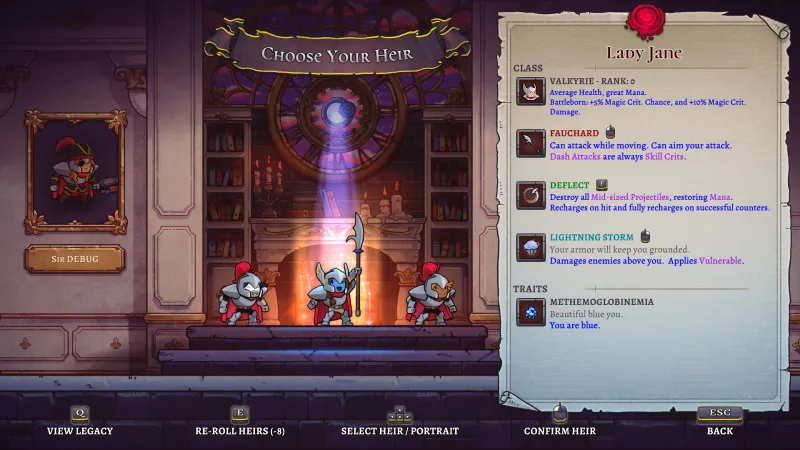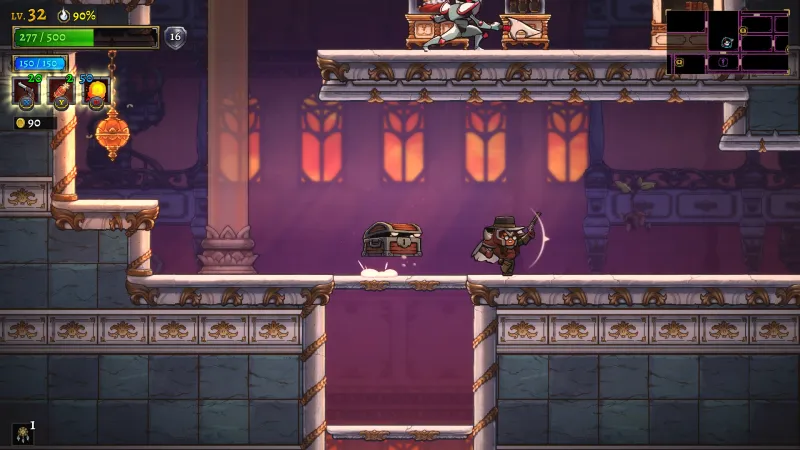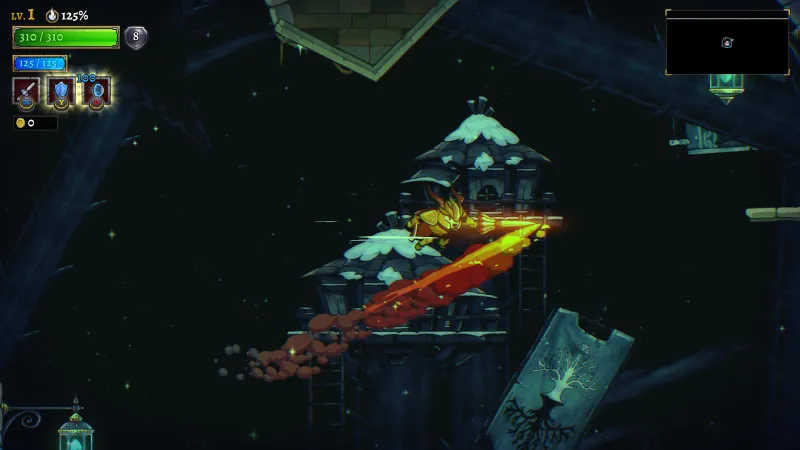Rogue Legacy 2 Review – Generations Of Greatness

Rogue Legacy 2 doesn’t make the biggest initial splash. In fact, at first glance, you’d be hard-pressed to see what’s changed from 2013’s Rogue Legacy to Cellar Door Games’ sequel. Despite switching from 2D sprites to a 3D rendered world, it veers close to the previous game’s aesthetic. While this lack of deviation from the original’s template proves to be a theme throughout Rogue Legacy 2, there are a lot of changes that add up to a bigger, better version of the original in almost every way.
Rogue Legacy 2 may have everything rendered in 3D. However, Rogue Legacy 2 maintains its 2D platforming roots. As an heir to a long and somewhat tragic bloodline, you run, jump, and attack using the weapon of that character’s inherent class. Each heir can add to their combat arsenal by having a unique class ability or a random spell linked to different face buttons. There’s also a nifty spin kick used to bounce off enemies or dangerous objects that’s critical to master to make it far into the dicey dungeons. The controls are tight and precise – making jumping and attacking curse-free affairs. It is simple to learn and easy to get back to the game after a while.

At the start of a run, you choose an heir to your bloodline with specific hereditary traits that make that character’s generation their own for better or worse. I love all the different variations of warriors these traits create, and that you’re rewarded for choosing someone with “bad” genetics. This adds depth and dimension to the concept of rogue-lite. The characteristic of a giant fighter could be that one fighter towers over his or her peers. A third may have colorblindness, which can change the way that grayscale is presented. Unfortunate vertigo can flip the world upside down for this run. A significant modifier is a trait that makes the game harder. This allows for greater gold accumulation over the course of a lifetime. These modifiables provide more wealth than the effort required.
With that gold, you can build up the bloodline’s castle, and the port town below it. After each run you can purchase skills that give permanent stat boosts to all characters. Strength, intelligence, health and many other attributes can also be increased. In town, you can craft new gear – which also offers stat bonuses and more with a full set of armor – before forfeiting the remainder of your cash and heading off on a new adventure. I’m glad the persistent upgrades are back, but I do have some problems with the system overall. Each rank of an upgrade is more expensive, resulting in lower returns for character improvement as well. It is also common to find the same upgrades nodes with similar stat boosts that others, which can lead you to spending more gold. The castle building menu becomes cluttered by redundant slots in the final game. It ends up becoming a much messier system that it should be.
Rogue Legacy expanded on class identities and they are now simpler. This time around, each heir’s class determines which weapon type they use and an additional ability they have at their disposal. Knights are equipped with a large sword that can be used to block enemy attacks and shield them from damage. Mages can fireballs at distance with their wand and have two spells, while Mages can cast fireballs and use one instead. Ranger can fire a bow from a distance and make leafy platforms for fire in the air. Pirates can take to the skies in airships and shoot cannonballs at any foes that are within their reach. Even though I didn’t find half the options feasible for me, I loved each identity. One class that I love is the Ronin (katana-wielding Ronin), and the Boxer (boxer), who can build up fast-fisted combos, then finish-off-targets with a powerful haymaker. The Bard creates music notes which you explode with a spin kick and the Gunslinger fires a lot of shots from their guns. Classes such as these require a great deal more finesse than I like.

Like Rogue’s visual style, Cellar Door Games decided the gameplay loop wasn’t going anywhere, which is great because I wouldn’t have it any other way. You will need to use your heir platform to traverse ever-changing, more difficult areas in order take out six Estuaries (the big bosses that guard each biome). During these battles, you’ll often die, upgrade your castle and gear, then repeat the process. Every trek to the citadel offers you the chance to make progress, find gold and treasure and to search for Relics that will increase your survival chances. The world’s layout changes every time you die, making every life in Rogue Legacy 2 mostly unique until you understand how the world populates.
Every area is unique in its own way. The area you will be exploring is the Citadel Agartha, a stone structure. You can then move on to other areas such as Axis Mundi (linear and waterlogged) to the east or Kerguelen Plateau to the west. There’s a tall tower to be climbed into the stormy skies, offering fun and challenging platforming to reach the Estuary at the top, and below the citadel lies a deadly and dangerous area that I hated going into, yet I love the difficulty it provides near the end of the game. Each area can be explored to earn armor blueprints that you can use in your town, as well as important mobility abilities that allow access to subsequent biomes. They include double jumps, dashes, and other abilities that work with mysterious items around the world. These can halt your progress. This form of progress was more based on exploration than the castle power upgrades. It felt incredibly fulfilling. This, plus the moves made it easier to get around makes my life much more enjoyable. Those little nuggets of joy only happen a few times over an entire playthrough, but what keeps an heir’s life interesting are persistent items for that run that affect attacks, abilities, or stats called Relics.

Like the various weapons that come part and parcel with each class, Relics are another addition to the Rogue Legacy formula the original didn’t have, making each run more entertaining. Relics are available in specific rooms within each region. While some are small changes, such as increasing critical hit chances for attacks and granting maximum health at the expense of some HP or giving you a greater chance to increase your HP, others can have a major impact on how you play.
Items like the marble statue, which causes a small projectile-nullifying shockwave whenever your feet touch the ground, are a blast to find and strategize around. I’m also a fan of the poison and fire effects that deal damage over time to add a little extra zing to every attack. However, collecting Relics has a drawback, and it’ll cost you your HP. Relics feed off a stat called resolve that’s tied to a given heir’s vitality. Your max health will drop if you possess enough Relics. This is in proportion to the cost of the magic item. It’s a risk/reward system that I understand would be too powerful if Relics were unchecked in some way, but I did lament that the game doesn’t let you go wild with every enhancement you find as other rogue-lites do.
Even after spending tens of hours scouring the dungeons of Rogue Legacy 2, there’s a lot to do and find beyond defeating the Estuaries and the final challenges that lie after. The story rooms contain diary entries that give backstories about the Estuaries, the region they rule over and other interesting information. However, this is not essential for enjoying the game. Your seaside port town also offers enemy gauntlets, enhanced boss encounters, and class challenges to test your skills beyond what’s available in the core explorable regions. I know I’ll be going back to uncover more and try to clear these more difficult scenarios.
Even though I have my quirks, each new discovery, skill gained, boss defeat, wipes out all grief and gives me deep satisfaction. There’s a lot to clean up with the core progression systems to make the ramp from beginning to end escalate more evenly, but I’ve enjoyed most of my hours struggling through countless generations of my goofy little bloodline. This series’ entertaining legacy is something I love.
#Rogue #Legacy #Review #Generations #Greatness








